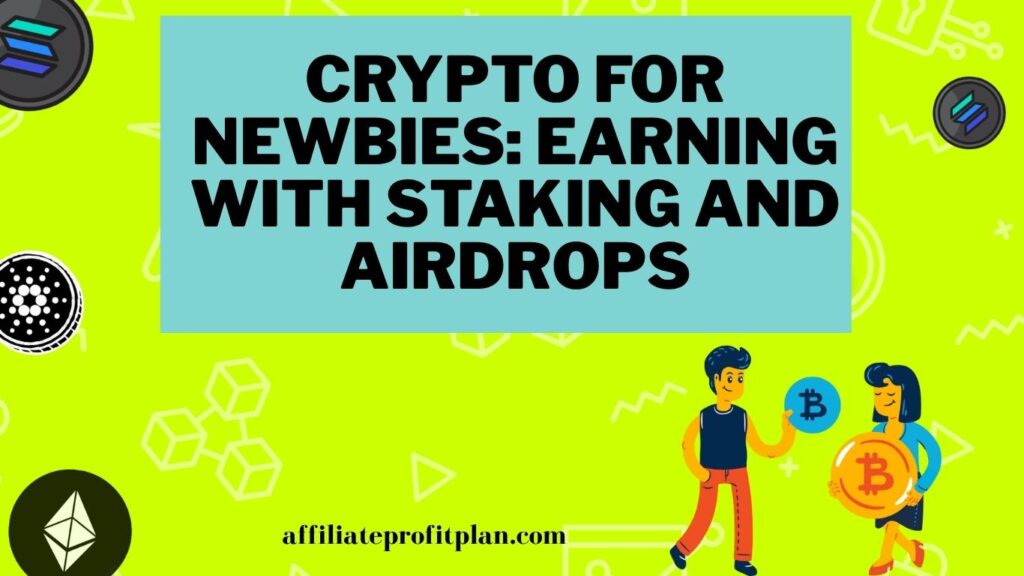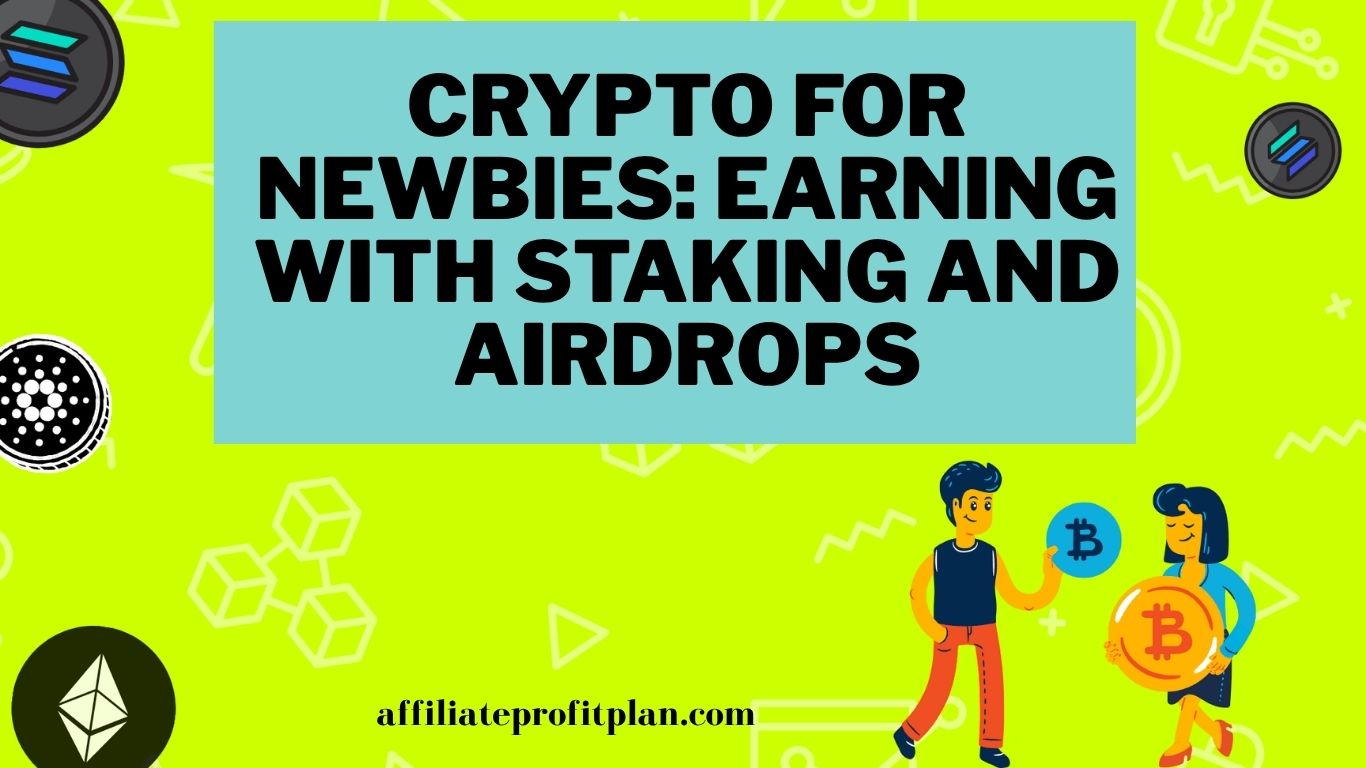Welcome to my article Crypto for Newbies: Earning with Staking and Airdrops. Let’s be honest — the world of crypto can feel like a chaotic soup of buzzwords, hype, and people on Twitter screaming about “the next 100x coin.” If you’ve ever opened a crypto app and immediately closed it because it looked like the Matrix and Monopoly had a baby, you’re not alone. But here’s the good news: you don’t have to be a blockchain wizard or a full-time degen to earn money in crypto. In fact, two of the easiest ways to get started — staking and airdrops — don’t require trading skills, mining equipment, or surviving on ramen.
In this beginner-friendly guide, we’re going to break down everything you need to know about staking and airdrops — how they work, how to get started, and most importantly, how to avoid scams that smell fishier than a sushi buffet on discount night. Whether you’re crypto-curious or just here for the free tokens, you’ll leave with a clear path to earning in the Web3 world — no coding, trading, or crypto tattoos required.
Access My Proven Blueprint for $50-$100 Daily Income – Watch This FREE Video Now >>>

🔐 What Is Staking and How Does It Work?
Okay, let’s demystify one of crypto’s most misunderstood money-making methods: staking. No, it doesn’t involve vampire hunters or grilling meat. In the world of crypto, staking simply means locking up your coins to help support a blockchain network — and getting rewarded for it. Think of it like putting your crypto to work while you binge Netflix.
Here’s the deal: certain cryptocurrencies (like Ethereum, Cardano, Solana, and Polkadot) run on something called Proof of Stake (PoS). Instead of relying on energy-hungry mining (like Bitcoin), these networks use validators — real people or platforms who “stake” their coins to help verify transactions and keep things running smoothly.
Now, unless you’re a tech-savvy millionaire with a fancy server farm, you’re probably not going to become a validator. But don’t worry — you can still earn rewards by delegating your coins to one. You keep full ownership of your assets, and they do the validating on your behalf. You just sit back and collect a slice of the reward pie. 🍰
Let’s say you have some ADA (Cardano). You find a reputable staking pool, lock up your ADA for a while, and boom — you start earning around 4–6% annually, paid in more ADA. It’s like earning interest, but your bank is now a decentralized network of computers and cryptographic math.
🧠 Important things to know before staking:
- Lock-up period: Some coins let you withdraw anytime, others make you wait days or weeks.
- APY (Annual Percentage Yield): This varies by coin and validator — higher isn’t always better (watch for sketchy pools).
- Risks: While staking is generally low-risk, your rewards depend on network conditions and validator performance.
In short: staking is your passive income gateway into crypto. You don’t need to trade, time the market, or speak fluent blockchain. Just pick a coin, find a good pool, and let your tokens earn while you nap. Or snacks. Or nap while snacking.
🎁 What Are Crypto Airdrops and Why Are People Getting Free Coins?
Let’s talk about the magical unicorn of the crypto world: airdrops — the mysterious moment when free crypto just shows up in your wallet like a digital fairy godmother made a deposit.
So, what exactly is a crypto airdrop? In simple terms, an airdrop is when a blockchain project gives out free tokens to people — often in exchange for doing small tasks (like following them on Twitter), holding a specific coin, or just being in the right place at the right time. No mining, no investing — just poof, free coins.
Why would anyone give away money like this? Good question, and no, it’s (usually) not a scam or the result of someone accidentally hitting “send all.” Airdrops are actually a marketing strategy. New crypto projects use them to:
- Reward early supporters
- Create buzz and grow their communities
- Distribute tokens widely for decentralization
- Incentivize testing of new platforms or features
Basically, they want you to care — and they’re willing to bribe you with shiny tokens to make it happen.
There are different kinds of airdrops, too:
- Holder airdrops: You automatically get tokens for holding a certain coin (e.g., if you held ETH at a specific time).
- Task-based airdrops: You complete small tasks — join a Telegram group, tweet a hashtag, or sign up for their newsletter.
- Surprise airdrops: You used a project months ago and forgot about it… then suddenly get rewarded (hello, $UNI and $ARB airdrops 👀).
😬 BUT WAIT — Not All That Glitters Is Gold
For every legit airdrop, there are shady knockoffs trying to steal your keys or infect your wallet with malware. Never share your seed phrase, and don’t click on links from “airdrops” in your DMs. If it smells fishy, close the tab and go eat a real fish taco instead.
In summary, airdrops = free crypto confetti, and when done right, they’re a fun (and sometimes surprisingly profitable) way to get involved in new projects — without spending a dime.
Step-by-Step: How to Start Staking as a Beginner
So you’re sold on staking — free(ish) money just for parking your crypto? Yes, please. But how do you actually do it without accidentally sending your coins to the shadow realm? Don’t worry. You don’t need a PhD in blockchain or a beard like a crypto wizard. Here’s your step-by-step, beginner-safe guide to staking:
Access My Proven Blueprint for $50-$100 Daily Income – Watch This FREE Video Now >>>
✅ Step 1: Pick a Staking-Friendly Coin
Not every crypto can be staked — just the ones that run on Proof of Stake (PoS) or a similar model. Here are a few beginner-friendly options:
- Ethereum (ETH) – now PoS! Great for long-term holders.
- Cardano (ADA) – low entry point, very popular.
- Solana (SOL) – fast, cheap, and widely available.
- Polkadot (DOT) – slightly nerdier, but solid rewards.
🔐 Step 2: Choose Your Wallet or Platform
You’ve got two main options:
- Exchanges (easiest) – Like Coinbase, Binance, or Kraken. You click a few buttons, and boom — you’re staking.
- Self-custody wallets (more control) – Like Trust Wallet, Keplr, or Ledger. Slightly more work, but you keep your keys (and your soul).
If you’re new, an exchange is fine to start. Just make sure it actually supports staking for the coin you picked.
🧙♂️ Step 3: Delegate to a Validator or Staking Pool
Unless you’re running a node (unlikely if you’re reading this), you’ll delegate your tokens to someone who is.
Think of it like picking a babysitter for your crypto — one who won’t run off to Vegas.
Tips:
- Choose a validator with good uptime and fair commission (look for 0–10% fees).
- Avoid pools that promise sky-high returns. If it sounds too good to be true… well, you know the rest.
⏳ Step 4: Wait, Chill, and Watch the Rewards Roll In
Once staked, your crypto starts earning rewards. Some platforms pay daily, others weekly. You can usually track everything in your wallet or staking dashboard.
Just be aware of lock-up periods — some coins require you to “unstake” and wait a few days before withdrawing.
🧠 Pro Tip:
Always double-check minimum staking amounts, network fees, and whether the rewards auto-compound (some do, some don’t — rude).
How to Find and Qualify for Legit Airdrops
If the idea of free crypto falling into your lap sounds too good to be true… well, sometimes it is. But sometimes it’s actually true — and all you need to do is show up, click a few buttons, and resist the urge to hand over your seed phrase to a stranger named “CryptoDave42.”
So how do you find the real airdrops (the ones that pay, not prey)? Let’s break it down:
📍 Where to Find Legit Airdrops
- Airdrop Aggregator Sites – These are like coupon websites but for crypto. Some solid ones:
- Airdrop Alert
- CoinMarketCap Airdrops
- Earnifi – even scans your wallet for unclaimed airdrops!
- DeFi Llama’s Airdrop Tracker – great for spotting upcoming DeFi projects.
- Airdrop Alert
- Crypto Twitter & Discord – Yep, the chaos has value. Follow major projects, influencers, and community managers. If they say “snapshot soon” or “early user rewards coming,” you might want to pay attention.
- Use New Platforms – Many airdrops go to users who simply used a product early. Just by interacting with a DeFi app or NFT marketplace, you might qualify for a future drop. (Think of it as “frequent flyer miles” for blockchain nerds.)
✔️ How to Qualify (Without Getting Scammed)
Here’s the typical airdrop checklist:
- ✅ Join their Telegram or Discord
- ✅ Follow their Twitter and like a few posts
- ✅ Fill out a form with your wallet address
- ✅ Use their app or platform if needed
- ✅ Hold a specific token at a “snapshot” date
Easy, right? But here’s what not to do:
- ❌ Never give out your private key or seed phrase. If someone asks, they’re not giving you free tokens — they’re taking yours.
- ❌ Avoid airdrops that require you to download sketchy files or pay upfront “unlock” fees.
- ❌ If it smells like a scam and walks like a scam… it’s probably a duck in a rugpull costume.
🧠 Bonus Tip:
Create a separate wallet just for airdrops. That way, if something goes sideways, your main holdings are still safe and sound.
In short: smart airdrop hunting is part detective work, part digital couponing, and part luck. But if you do it right, your crypto wallet just might get a few surprise gifts — no effort, no investment, and no weird uncle trying to sell you Doge.
Is It Worth It? Pros, Cons, and Realistic Expectations
By now, you might be thinking, “Okay, staking sounds chill, and airdrops sound like scratch-off tickets with fewer quarters involved… but is this stuff actually worth my time?”
Great question. And like any good crypto answer: it depends. So let’s break down the pros, cons, and the not-so-shiny truths about staking and airdrops — minus the hype and moon emojis.
👍 The Pros (a.k.a. Why People Love This Stuff)
- Low Effort, Low Barrier – No need to learn trading charts, predict markets, or build a mining rig in your garage. You can stake or airdrop-hunt in your sweatpants.
- Passive Income – Staking offers steady, hands-off returns. You literally earn while you sleep, scroll, or snack.
- Exposure to New Projects – Airdrops can give you early access to tokens that might blow up. (Keyword: might.)
- Stacking Without Spending – Airdrops can pad your portfolio without dipping into your bank account. Free is a beautiful number.
👎 The Cons (a.k.a. The Fine Print No One Tells You)
- Returns Can Be Small at First – Unless you’re staking large amounts or catching a big airdrop, early earnings may not exactly scream “retire early.”
- Volatility Still Applies – Your staked tokens can drop in value — so 6% APY on something that just crashed 30% isn’t much of a win.
- Airdrops Can Be… Meh – For every legit $1,000 UNI airdrop, there are ten $0.0004 “FluffyMoon” tokens that do nothing and go nowhere.
- Scams Are Everywhere – Seriously, if airdrop hunting had a danger level, it’d be somewhere between “dodgy Craigslist ad” and “pirate treasure map with ketchup stains.”
🎯 Realistic Expectations
- You won’t get rich overnight. Staking and airdrops are long games. Think of them as digital gardening: plant, water, wait — then maybe harvest.
- Treat this as supplemental income, not a full-time job… unless your full-time job is tweeting about coins at 2 a.m. and drinking caffeine like a DeFi degenerate.
- Start small, learn as you go. Your first airdrop may be worth $2, and your first staking reward might buy you a latte — but it’s about momentum and compounding, not instant Lambos.
Bottom line? Staking and airdrops are 100% worth exploring — as long as you go in with eyes open, expectations realistic, and scams avoided. You’re not playing the lottery… you’re building a foundation.
Conclusion: Your First Steps into the Crypto Wild West
So there you have it — staking and airdrops, demystified, de-jargonized, and (hopefully) a little less intimidating than they seemed 10 minutes ago.
Access My Proven Blueprint for $50-$100 Daily Income – Watch This FREE Video Now >>>
The truth is, crypto doesn’t have to be an all-or-nothing rollercoaster of day trading and heartburn. You don’t need six monitors, an algorithmic bot, or a Reddit username like “HODLKing420.” Sometimes, making money in this space can be as simple as holding your coins, clicking a few buttons, and letting the blockchain do the heavy lifting.
- Want a safer, slower approach to grow your portfolio? → Try staking.
- Want to hunt down free coins like a blockchain bounty hunter? → Look into airdrops.
Either way, you’re not just learning how to earn — you’re getting hands-on experience with the future of finance (and maybe collecting a few surprise tokens along the way).
✅ Your CTA: Start Small, Stay Smart
Here’s what to do next:
- Pick one staking-friendly coin (like ETH or ADA) and try staking it — even just a small amount.
- Bookmark airdrop trackers and join a few project communities on Twitter or Discord.
- Create a separate wallet just for airdrop hunting — keep your main funds safe.
- Stay skeptical. If someone DMs you with “guaranteed returns,” it’s not an opportunity — it’s a digital pickpocket.
And most importantly: keep learning. The crypto space moves fast, but you don’t have to sprint to keep up. One step (or stake) at a time.
Still have questions about staking, airdrops, or why so many coins are named after dogs? Drop them in the comments or shoot me a message — no blockchain degree required. 🐶💸
Let the crypto earning begin!
Thanks a lot for reading my article on “Crypto for Newbies: Earning with Staking and Airdrops” till the end. Hope you’ve helped. See you with another article.










